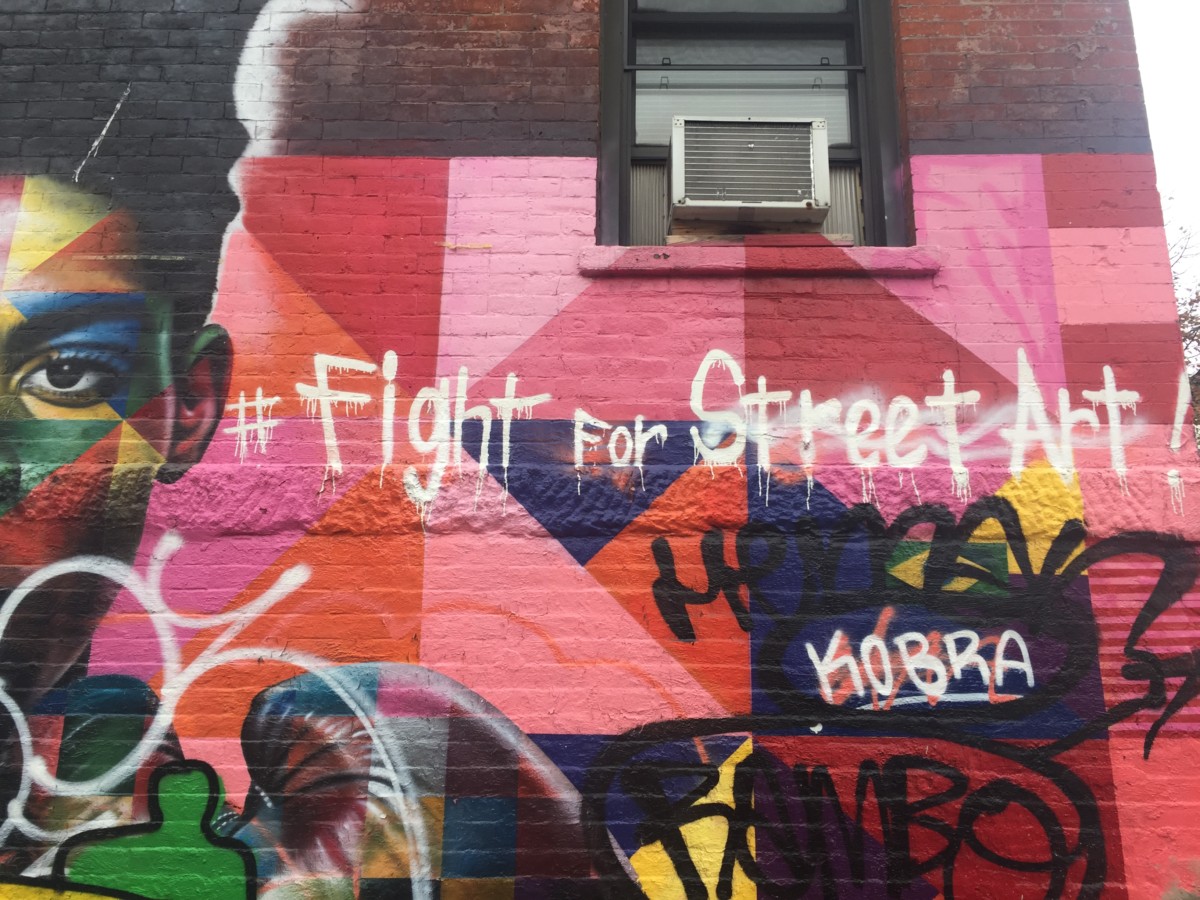As gentrification morphs the remnants of Williamsburg’s once-thriving art scene into a sightseeing stop for tourists, artists who once loved the area feel more and more pushed aside on the streets they once called home.
One of them goes by the name Lungebox. As a street artist, he is still working in Williamsburg, but he’s not sanguine about the changes there. “I used to feel sort of at home in the neighborhood,” he said. “Now, I definitely feel a shift in the demographic, and I have a perspective as an artist to see if there is a waning in the art in the neighborhood. A lot of my artist friends have left as well.”
Lungebox, pushing 50, has been doing art his whole life. Influenced by the likes of Rick Griffin, much of Lungebox’s art characteristically features an eyeball as a recurring motif. He is a self-taught artist, who, through trial and error over the decades, started to put his work on the streets around three years ago. But he says he is running out of places to paint. Art spots, he said, “are dwindling. There’s tons of construction around here. What were abandoned buildings are now condos. I’ve seen so many neighborhoods in the city change,” he continued, “from having defining characteristics, to changing to where the Duane Reade is in relation to the Chase Bank.”
Holly Stevenson, another North Williamsburg Resident and art aficionado, still sees Williamsburg as a highly artistic area, with a palpable quirkiness that isn’t present in Manhattan. However, “in the space of three years the rent has doubled,” she says, as developers built huge condos. Some of these condos even take up such a large amount of space that they required new zip codes to accommodate them, Stevenson lamented.
And Stevenson doesn’t think that the new set of residents moving into Williamsburg are the artistic type, just people leaving Manhattan for cheaper property prices. Whether it is poetic justice or simply the harsh reality of the real estate market, the artists who gentrified Williamsburg in the 1980s are being gentrified. As a consequence, many of the music halls and art galleries where they gathered and worked have shut down in recent years, according to Stevenson.
Colossal Media is one of the most recent art spaces forced to close its warehouse in Williamsburg. Colossal Media is an internationally recognized branding company, which incorporates hand art, graffiti, and street art into corporate advertising murals, many of which are displayed on the exterior of old factory walls in Williamsburg. According to Kara Ayers, Studio Manager for the company, Colossal’s warehouse is being pushed of Williamsburg to Greenpoint. The warehouse is the space where Colossal’s painters store their equipment and work on their pre-production and patterning, but the warehouse space was recently sold, leaving Colossal with no choice but to split the locations of their warehouse and office. According to Ayers, the buyers plan to replace the creative warehouse space with a high rise condo. Ayers said that she is disappointed about the move, but appears unsurprised by it, noting that there is not much street art left in Williamsburg, besides Colossal’s murals.
David Meade is a former street art tour guide who also attests to the fading of the art scene, not only in Williamsburg but, he believes, across Brooklyn. He thinks that even Bushwick, home to many of Brooklyn’s artists these days, is undoubtedly the next neighborhood on the chopping block. Meade is a New York native, who describes himself as always being “interested in urban culture, graffiti, and hip hop.” Street art came onto his radar in the the early 2000s. After a move to Williamsburg in 2006, Meade wanted to share his love of street art with the world, so he set up his own street art tour based in Williamsburg called Street Art Walk with David Meade.
But like others, Meade sees an irony in how things have played out Williamsburg. It was the art itself, he says, that led to furthering gentrification in Williamsburg. “It set the table for the gentrification. The art has a pulse and dynamism that can be turned into real estate play, which is what happens in gentrification cycles. And Williamsburg was that cycle on steroids.”
The pace at which Williamsburg has gentrified has been startling, some of its inhabitants say. “From 2011 to 2015 when I left, it had already changed dramatically,” noted Meade. Like Stevenson, Meade has also noticed that the new Williamsburg residents aren’t particularly artistic. “They are more about money and high culture,” he said. “And that’s not what people went to Williamsburg for. You can go to SoHo or Tribeca for that more established order.”

Yet as Williamsburg residents notice a decline in the eclectic art that once characterized their neighborhood, tourists who visit think the area is buzzing with art. Peter Pierhoefer and Sandra Strasser are tourists from Zurich, Switzerland, who visited Williamsburg recently—purely for the art. “Williamsburg is the part for the artists,” said Strasser.


Leave a Reply